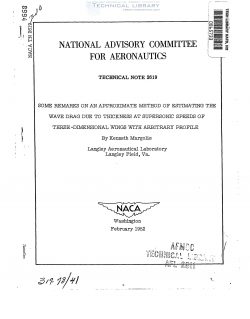naca-tn-2619
- Version
- 49 Downloads
- 444.05 KB File Size
- 1 File Count
- January 9, 2017 Create Date
- January 9, 2017 Last Updated
National Advisory Committee for Aeronautics, Technical Notes - Some Remarks on an Approximate Method of Estimating the Wave Drag Due to Thickness at Supersonic Speeds of Three Dimensional Wings with Arbitrary Profiles

A semiempirical profile—correction factor is discussed which enables
the estimation of the wave drag due to thickness at supersonic speeds
for three—dimensional wings with arbitrary airfoil section (subject to
the restrictions of thin—airfoil theory) through use of previously
calculated drag coefficients. Application of the proposed’correction
factor to the known drag coefficients of some rhombic—profile wings
yielded estimates for the drag coefficients of parabolic—arc—profile
wings that were in good agreement with theoretically calculated values.
It is expected that satisfactory estimates can be obtained for many
combinations of plan fonm and profile by Judicious use of the proposed
profile correction, especially at speeds for which the wing leading edge
is supersonic.
A number of papers dealing with the linearized—theory calculations
of supersonic wave drag at zero_1ift (that is, drag due to thickness) for
three—dimensional wings have been published. (See references 1 to 12,
for example.) As a result, extensive theoretical data are available for
the wave-drag coefficient at supersonic flight speeds for wing plan fonms
that have arbitrary sweepback (0r sweepforward) , taper ratio , (and aspect
ratio. The profiles of these wings, however, are in general restricted
to symmetrical double wedges, rhombuses (symmetrical double wedges with
maximum thickness located at 50 percent chord), and biconvex sections
composed of two symmetrical'parabolic arcs. other types of thin small-
slope airfoil sections require a_great deal of mathematical and compu-
tational labor and have been avoided in the theoretical analyses.
Inasmuch as these other profiles may prove to be of interest
because of structural advantages, low-drag characteristics, and other
reasons, it would be desirable to be able to obtain estimates of the
drag for these cases without having to resort to further theoretical
investigations. The purpose of the present paper, therefore, is to
discuss the application and limitations of some semiempirical profile
corrections which will enable the-estimation of the wave—drag coefficient
for three—dimensional wings with various profiles by utilizing previously
calculated drag coefficients.
| File | Action |
|---|---|
| naca-tn-2619 Some Remarks on an Approximate Method of Estimating the Wave Drag Due to Thickness at Supersonic Speeds of.pdf | Download |
Comment On This Post